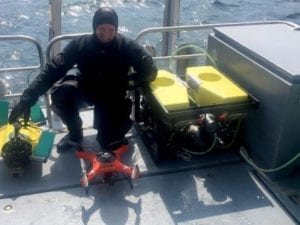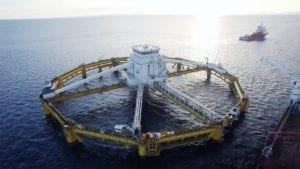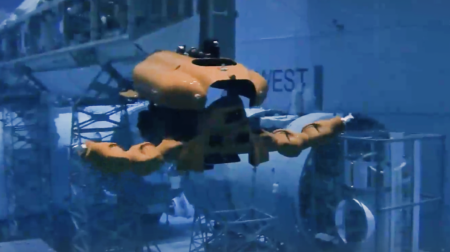A robotic turtle designed to investigate shipwrecks on the sea floor could be used to improve the monitoring of salmon farms.
The U-CAT robotic turtle was developed at Tallinn University of Technology in Estonia for underwater archaeology applications.
However, the small and highly manoeuvrable robot could replace human divers and underwater vehicles tasked with inspecting sea cages that can hold as many as 200,000 farmed salmon.
As well as monitoring the health of the salmon and checking for breaches in the cage, the robotic turtle causes less stress to the farmed fish, according to a team from the Norwegian University of Science and Technology’s (NTNU), SINTEF in Trondheim, Norway, and Tallinn University of Technology.
Their experiments show that the fish are only negligibly scared or stressed by the robotic turtle. The salmon swam calmly and close to the robotic turtle, but avoided intruders in experiments with divers and thruster-driven underwater robots.

According to Maarja Kruusmaa, a professor at NTNU’s Department of Engineering Cybernetics and at Tallinn University of Technology, “the overall purpose of the experiments wasn’t just to test the turtle robot, but also to investigate what characteristics robots being used in the aquaculture industry should have”.
The team found that the most important characteristics of the surveillance robot are its size and speed.
“Colour and motor noise hardly matter at all,” added Kruusmaa. “The conclusion turned out to be the opposite of our expectations.

“The fact that the robot looks like a marine animal doesn’t seem to play any role at all.
“And that’s actually good news – it means we don’t have to build the robots to be fish- or turtle-like.
“That will make it cheaper to develop and use robots in this new field of application to monitor marine organisms.”
Kruusmaa and Jo Arve Alfredsen, an associate professor in the department of engineering cybernetics at NTNU, published their findings in Royal Society Open Science.
Both are employed by NTNU AMOS – the Centre for Autonomous Marine Operations and Systems, which is developing new types of underwater vehicles and offshore monitoring methods.

Robots such as the robotic turtle can be connected to various measuring instruments and sensors to provide fish breeders with online updates and monitoring of life in the sea cage.
Using robotic technology instead of divers for surveillance allows monitoring to continue without interruption and this continuity can contribute to quicker responses, greater predictability, better fish welfare and lower mortality.
The researchers carried out the practical experiments in SINTEF Ocean’s full-scale aquaculture laboratory ACE, operated by SalMar, a Norwegian fish farm company, as part of the EU project AQUAEXCEL2020.
Want to read similar stories to this?







